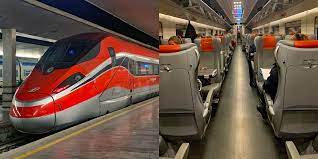I traveled on a high-speed train from Florence to Rome for $46, and I’ll never choose the standard option again

Joe Opaleski
I visited Italy in September to celebrate my sister’s birthday and opted to travel by train instead of renting a car.
Most of my travel in the country required taking regular passenger trains, but my flight from Rome left at 10:30 a.m. the morning after a stay in Florence, so I needed an efficient method to get to the airport as early as possible.
Trenitalia, one of two major train operators in Italy, offers a high-speed rail system, or “bullet train,” from Florence to Naples that stops in Arezzo and Rome. My train, which cost $46, left Santa Maria Novella station in Florence at 6 a.m. and arrived at Roma Termini at 7:49 a.m.
I routed all my trains ahead of time via Trainline, a third-party app that allows you to buy train and bus tickets in most European countries.
Getting to Santa Maria Novella in Florence is easy if you have a map or a phone that can route your path. From popular sites like the Duomo and Ponte Vecchio, it’s about a 15-minute walk.
To make things even easier, I rented an Airbnb that was only about five minutes from the station.
On the morning of my departure, I walked the short distance to Santa Maria Novella and double-checked the train’s departure time. There were several options for coffee and breakfast, but I arrived around 5:45 a.m., and most places were closed. If I had been desperate, there was a large McDonald’s on the station’s northeast corner.
The station can be overwhelming with crowds of people during high-traffic times, but it was nice to be in there with only a few people early in the morning.
The only confusing issue I ran into at the station was that the ticket I purchased through Trainline showed Rome as the destination, but the timetable showed Naples. When I didn’t see Rome listed on the timetable, I cross-referenced the train’s number and checked with a station employee to be sure I was boarding the right train.
They were helpful and confirmed which platform I needed to be on.
Unlike other passenger trains I took in Italy, the bullet train had assigned seats and carriages. But I entered my assigned carriage and found someone else sitting in my seat, so I chose a different one with a better view.
The seats were spacious, and I was grateful to have adequate legroom and overhead luggage storage.
I was fully situated in my carriage at 5:55 a.m. and was pleasantly surprised when they announced in both Italian and English that the train would depart at 6 a.m. This announcement was the only warning before the train began moving at 6 sharp, validating my decision to stay close to the station and arrive early for my trip.
The bullet train had better amenities than standard passenger options
The seats were larger and more spacious than other Italian trains I rode. Even with the faster speed of the bullet train, I was able to take in some relaxing views of the countryside as the sun rose over Tuscany.
About 20 minutes into the trip, an attendant entered our carriage to check tickets. She was able to scan my virtual boarding pass — which I transferred to my Apple Wallet from the Trainline app — and she didn’t seem concerned I wasn’t in my assigned seat.
After I showed my ticket, I ate a snack and tried to catch up on some much-needed sleep.
The train had bathrooms and a small food stand, but I brought my own snacks from my favorite Italian grocery store, Superconti.
The train got more crowded as we approached Rome, and we had 2 delays
I woke up toward the end of the trip and noticed we had a 10-minute delay to my destination. We also picked up more passengers in Arezzo who largely appeared to be commuting to Rome.
The first stop in Rome was at a station called Tuscolana, and an announcement came on explaining that the train was delayed again.
I decided to wait since we were still only a few minutes behind schedule and took in the city views and nearby graffiti. But an attendant soon alerted us that we were delayed indefinitely and would need to take a separate train to Roma Termini.
This interruption didn’t add too much time to my trip, but it was stressful switching trains in the crowded Tuscolana station. The new train was quite full, and I stood with my luggage the whole ride.
From Termini, it was an easy transfer to the airport via the 30-minute Leonardo Express train, which seemed to run every 15 minutes.
Overall, I’d recommend taking the bullet train from Florence to Rome instead of the regular passenger train because it was faster, had fewer stops, and provided comfortable amenities.
Even though I experienced a few delays and interruptions, it was quick enough to get me to the airport on time for my morning flight.
I also highly recommend using the Trainline app to book European trains. It allowed me to route my trains ahead of time, add my boarding passes to my Apple wallet, and purchase tickets with Apple Pay.





